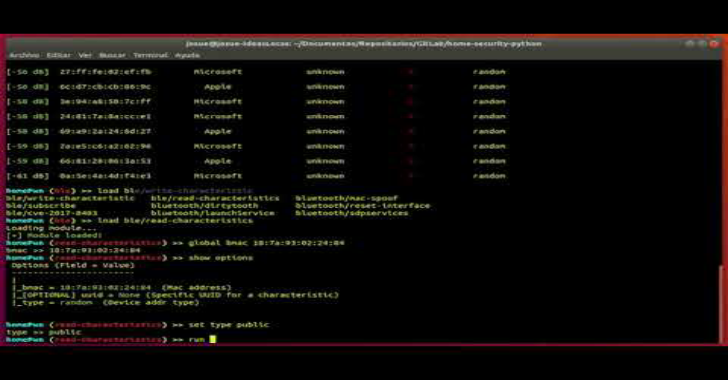HomePwn is a framework that provides features to audit and pentesting devices that company employees can use in their day-to-day work and inside the same working environment.
It is designed to find devices in the home or office, take advantage of certain vulnerabilities to read or send data to those devices. With a strong library of modules you can use this tool to load new features and use them in a vast variety of devices.
HomePwn has a modular architecture in which any user can expand the knowledge base about different technologies. Principally it has two different components:
- Discovery modules. These modules provide functionalities related to the discovery stage, regardless of the technology to be used. For example, it can be used to conduct WiFi scans via an adapter in monitor mode, perform discovery of BLE devices, Bluetooth Low-Energy, which other devices are nearby and view their connectivity status, etc. Also, It can be used to discover a home or office IoT services using protocols such as SSDP or Simple Service Discovery Protocol and MDNS or Multicast DNS.
- Specific modules for the technology to be audited. On the other hand, there are specific modules for audited technology. Today, HomePwn can perform auditing tests on technologies such as WiFi, NFC, or BLE. In other words, there are modules for each of these technologies in which different known vulnerabilities or different techniques are implemented to asses the device’s security level implemented and communicated with this kind of technologies.
Also Read – FOCA : Tool To Find Metadata & Hidden Information In The Documents
Installing All Requisites
To install all dependencies in Ubuntu 18.04 or derivatives use the file install.sh
> sudo apt-get update
> sudo ./install.sh
The script ask you if you want to create a virtualenv, if your answer is ‘y’ then it installs python libraries within the virtual environment, if not in the system itself
To run the script, if you chose a virtual environment in the installation follow execute the next command to activate the virtual environment:
> source homePwn/bin/activate
Launch the application:
> sudo python3 homePwn.py
Here are some videos to see how the tool works.
HomePwn. Bluetooth Low-Energy PoC & Hacking
HomePwn. Bluetooth Spoofing
HomePwn. NFC Clone
HomePwn. BLE capture on PCAP file (sniffing)
HomePwn. QR Options hack
HomePwn. Apple BLE Discovery
HomePwn. Xiaomi IoT Advertisement
Disclaimer!
THE SOFTWARE (for educational purpose only) IS PROVIDED “AS IS”, WITHOUT WARRANTY OF ANY KIND, EXPRESS OR IMPLIED, INCLUDING BUT NOT LIMITED TO THE WARRANTIES OF MERCHANTABILITY, FITNESS FOR A PARTICULAR PURPOSE AND NONINFRINGEMENT. IN NO EVENT SHALL THE AUTHORS OR COPYRIGHT HOLDERS BE LIABLE FOR ANY CLAIM, DAMAGES OR OTHER LIABILITY, WHETHER IN AN ACTION OF CONTRACT, TORT OR OTHERWISE, ARISING FROM, OUT OF OR IN CONNECTION WITH THE SOFTWARE OR THE USE OR OTHER DEALINGS IN THE SOFTWARE.

















